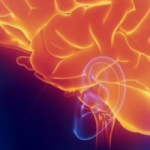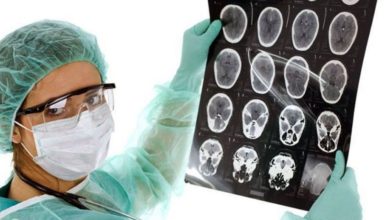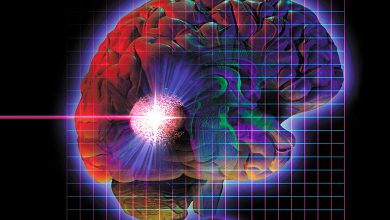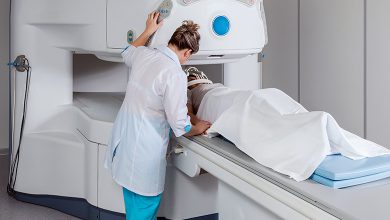Tumor of the temporal lobe of the brain
The content of the article
The brain is extremely susceptible to the development of neoplasms. Depending on their location, they can be classified as a tumor of the temporal lobe of the brain, frontal, parietal, etc. According to official statistics, over the last decade the number of patients has increased by 15% and therefore the increase in mortality in the world is increasing. Tens of thousands of people learn every day that they have a brain tumor. Of course, the likelihood of such a neoplasm is small, but it still poses a high threat.
Basic information about brain tumors
This type of tumor is characterized by the fact that it is located directly inside the skull. It can be detected in any person, regardless of age and gender. The main division of these tumors is as follows:
- benign;
- malignant.
If we consider the situation more professionally and deeply, then they can be classified as:
- primary type tumors, which are formed directly from nerve cells;
- tumors of the secondary type or, as they are often called, metastatic. These tumors appear due to infection of tumors located in other places, usually through the blood.
It is important to note the fact that the secondary type of tumors is much more common. In addition, they are always malignant.
If we consider from a scientific point of view, there are more than 100 different types of tumors that have unique characteristics. Moreover, all these cases can be combined according to the principle of being inside the skull and compressing neighboring structures.
They have specific symptoms, which can be divided as follows:
- local in nature, which appear at the site of the tumor. They are called primary and refer to focal symptoms;
- affecting due to the occurrence of edema or any other reason caused by the development of oncology to a certain size. Called secondary, they refer to focal symptoms;
- general symptoms that appear due to increased pressure inside the skull, due to a gradual increase in infection, are classified as general cerebral.
It is impossible to accurately answer the question of which type of symptoms will appear first. For example, when a tumor develops in the frontal part of the brain, one person will first have focal symptoms, while another will have general cerebral symptoms.
Features of cerebral symptoms
Pain that occurs in the head can be called the most obvious and common symptom of this type. In about a third of cases, this is an obvious sign of tumor growth.
Characterized by pressure from inside the skull. It does not have a clearly defined place where it hurts the most. At first, the pain may occur occasionally, but then becomes unresponsive even to any type of painkiller. It manifests itself more strongly in the morning, due to the structural features of the human body. A person sleeps in a horizontal position, in which the outflow of cerebrospinal fluid and blood is somewhat more difficult. After waking up and taking a vertical position, everything is gradually restored and returns to normal.
Common vomiting is also a general cerebral symptom. At the same time, it is easy to distinguish this type from that caused by poisoning or gastrointestinal problems. Vomiting caused by a tumor is regular, cannot bring a person relief, is not associated with food and is accompanied by a headache.
There are situations when vomiting is a focal symptom. This appears when the tumor is located in the area of the bottom of the fourth ventricle. Vomiting occurs due to head movement and is accompanied by accompanying reactions such as excessive sweating, irregular heartbeat, hiccups and others.
Vision problems are the main indicator of all types of tumors that arise in the brain. As a rule, they appear after the tumor has grown to a large size. Vision is constantly deteriorating. Cannot be corrected with lenses. A fog effect may occur.
Another important symptom is mental problems. Memory, attention, and emotionality of a person are greatly removed from normal indicators. These symptoms, which occur in an ordinary person, can suggest the appearance of oncology in the head.
Epilepsy attacks occur in a third of patients. This seizure is a clear sign of a tumor when it occurs in a person who has not previously suffered from it.
Features of focal symptoms
When a person develops a tumor of the frontal lobe of the brain, temporal, occipital or any other, the following focal symptoms may appear:
- Problems related to sensitivity. This type of problem includes numbness, burning, pins and needles, loss or decrease in sensitivity of certain parts of the body, as well as the inability to pinpoint exactly where a part of the body is with the eyes closed.
- Related to the musculoskeletal system. Muscle strength decreases, their tone changes, and Babinski's symptoms appear. Depending on where exactly it is located and what size the tumor is, it can affect one, two or all limbs.
- Related to speech, reading and writing. They arise due to the fact that the tumor is located in the areas of the brain responsible for these actions. They usually develop gradually, in proportion to the growth of the tumor. Can lead to complete numbness of a person.
- Epilepsy attacks. There are two types: partial and generalized. The former are exclusively focal symptoms, the latter are cerebral.
- Problems with coordination. Occur when infected tissue appears in the cerebellar area. The gait changes greatly, and the likelihood of falling increases. Dizziness is often an accompanying symptom. Problems arise with performing precision operations.
- Cognitive problems. Over time, as the tumor grows, memory and logic deteriorate, and a certain absent-mindedness occurs.
- The appearance of hallucinations, which come in various types: from ordinary taste and olfactory to visual and auditory, which occur for a short time.
- Problems arising in the cranial nerves. They appear due to the fact that the tumor puts strong pressure on the nerve roots. These include vision problems of various types, painful sensations very reminiscent of neuralgia, problems with the functioning of the masticatory muscles, facial asymmetry, hearing problems, loss of taste, difficulty swallowing, and a sudden change in voice.
- Vegetative problems. They appear due to pressure from the tumor on the existing autonomic centers in the brain. Characterized by a sharp change in pulse, blood pressure, and breathing. There may be headache and vomiting.
- Hormonal problems. They appear due to pressure from the tumor on the pituitary gland . In addition, it may be a consequence of the action of tumors that are hormonally active or, in other words, producing hormones. Severe obesity, diabetes, impotence and other hormonal problems occur.
The main symptoms of tumors in different parts of the brain
Of course, a person confronted with the presence of a tumor is explained exactly where it is located. Depending on the lobe of the brain where the tumor is located, symptoms may differ. When a tumor of the frontal lobe of the brain appears, it is quite difficult to give a prognosis, especially if it occurs in the anterior part, where the area cannot be diagnosed for a long time. In this situation, the main signs that will indicate the likelihood of this disease occurring are symptoms of a general cerebral nature. A serious change in character can be called important, but, unfortunately, many do not pay much attention to this, attributing it to stressful situations. Only after more serious symptoms appear does the sick person consult a doctor.
In the event that a tumor occurs in the left part of the frontal lobe in the posterior lower regions, the first symptom indicating the presence of the disease is problems with speech functions. Errors in words and sounds. Accompanied by a certain weakness of the tongue and the right side of the face. All this is typical for right-handed people; left-handed people have similar symptoms.
Like other types of brain tumors, cancer in the temporal lobe is best detected and clearly localized using computed tomography. The occipital lobe is the smallest of all parts of the human brain and is located next to the parietal and temporal lobes. Divided into wedge and gyrus.
When a person develops cancer in the occipital lobe of the brain, symptoms are primarily hallucinogenic. As a rule, the sick person sees flashes, various figures appearing in different places. Then there is a gradual deterioration of vision, complete or partial. The central part of the field of vision may also fall out. Quite often problems arise related to determining the desired color.
It is important to note that tumors that arise in the occipital lobe affect those parts of the brain with which they come into contact. Because of this, various focal symptoms arise. For example, in the case of pressure from a tumor directly on the cerebellum, many problems with gait and muscles appear. Epilepsy may occur.
The most effective detection tool besides computed tomography from an information point of view is angiography.
When a tumor of the temporal lobe of the brain develops, the symptoms are as follows:
- epilepsy attacks;
- hallucinations of various kinds.
Epilepsy attacks are preceded by hallucinations. They can be of any nature: from visceral to visual. In the case of gustatory and olfactory hallucinations, people experience rather unpleasant smells and tastes. These include the aroma of rotten eggs, the smell of kerosene and smoke, and the taste of metal in the mouth. Various auditory hallucinations may occur.
Visual hallucinations are quite complex when they occur. Works of art, murals, animals and people can be seen. In this case, hallucinations can be perceived either positively or negatively.
As the disease progresses, a rather dangerous episode can occur. Hallucinations and seizures of epilepsy constantly increase, and at one point in time disappear. As a result, people believe that they have recovered and stop treatment.
When the left lobe of the temporal lobe is affected, hearing is impaired. First of all, analyzing the speech of other people stops working. A person cannot understand what is said to him, and at the same time he is also unable to communicate clearly on his own. A fairly common symptom of a tumor that affects the border of the temporal and occipital lobes is forgetting the names of objects.
It is important to note that quite often diagnosing the disease is very problematic. Of course, all this can be successfully solved by computed tomography, but it will not be prescribed without the presence of various kinds of symptoms. Sometimes meningioma can grow to a very large size without showing any signs of its existence. Only gradually do cerebral symptoms increase. Various benign tumors grow at a very slow pace, but have much more pronounced symptoms and signs, usually focal. And the same glioblastoma and other types of malignant ones, on the contrary, have very fast-growing and manifested cerebral and focal symptoms that cannot be missed.
How to treat?
The treatment process for a brain tumor must be highly individualized. The methods that will be used depend on a number of different features. These include a person’s age, level of health, and presence of diseases. But all these are additional factors, the main thing being its size, type and location.
The main goal of surgical treatment is to identify the tumor and remove it from the brain through surgery. Sometimes, as a rule, in the case of benign tumors , this method can completely eliminate the problem.
In the case of malignant neoplasms in other parts of the body, both the tumor and neighboring healthy tissues are excised. This is done as part of the fight against potential relapse. But this method is absolutely not applicable in brain surgery.
So-called stereotactic surgery is being used increasingly. This method involves treatment without surgery using radiosurgery techniques such as gamma knife and proton surgery. It is very progressive and must be used when there is a tumor of the temporal lobe of the brain, frontal, occipital and other parts and there are no contraindications to the use of such methods. The number of potential complications is much less than with traditional surgery.
Before surgical intervention, conservative treatment is carried out:
- steroids that have a pronounced anti-inflammatory effect are used to reduce the size of the edema;
- drugs are used to stop seizures in order to prevent an epileptic attack or minimize the likelihood of its occurrence;
- a special operation may also be performed to drain excess fluid through a special catheter.
radiation therapy is currently actively used . This method has proven to be a reliable method of fighting cancer in other parts of the human body, and it is logical that it is also used in the treatment of brain tumors.
It is used, as a rule, in cases where surgical intervention is impossible. Sometimes used after surgery to dramatically reduce the potential risk of recurrence. Carried out at the local level. For example, if there is a tumor in the frontal lobe of the brain, then it is this section that will be irradiated, and not the entire brain.
Radiation therapy regimens usually come in two types:
- Outdoor. A high-intensity beam of radiation is used. Performs in about 5 minutes, 5 days a week, several weeks.
- Brachytherapy. It is produced by introducing radiation grain directly into the tumor, which acts from the inside. The procedure is performed in a hospital over several days.
Chemotherapy is usually used in conjunction with radiation. It is a pronounced systemic method, due to its effect on both infected and healthy cells in the human body. Usually a complex of different drugs is used. It can be administered by injection or taking tablets orally. A special shunt is rarely used.
The level of effectiveness increases when this method is used in conjunction with irradiation. Typically, chemotherapy is given in cycles over several weeks. In general, several cycles are carried out and then a break to determine how effective the treatment was. This type of treatment can be characterized as having large side effects. Affects the gastrointestinal tract, bone marrow.
The advantages of radiosurgery include the absence of a scalpel and, accordingly, the impossibility of complications arising due to surgical intervention. In addition, this is the only way to get to places where you can’t go the usual way. There are no areas in the brain that are inaccessible for radiosurgery. As a result, people whose tumors were inoperable . This also applies to very severe cases that occur when there are tumors in the temporal lobes of the brain.
And finally, endoscopic interventions. This is a specific type of traditional surgery for the treatment of brain cancer. The classic operation requires mandatory trepanation, in other words, the skull is opened. This can lead to unexpected complications and injuries. In turn, endoscopic intervention is characterized by the presence of small incisions, which are carried out using special endoscopic equipment.
This method makes it possible to preserve intact all the small vessels and nerves located in the brain, which would undoubtedly be damaged in the case of traditional surgery. This type of treatment can also pump out excess fluid from the ventricles of children. An example of an endoscopic type of operation is the removal of a pituitary adenoma through the nose .
Please rate the article:

 (7 ratings, average: 4,29 out of 5)
(7 ratings, average: 4,29 out of 5)



